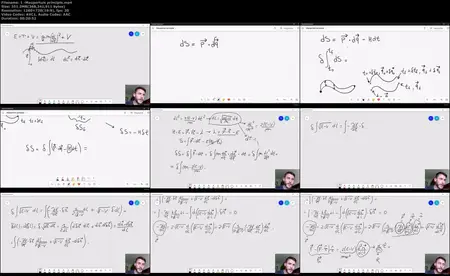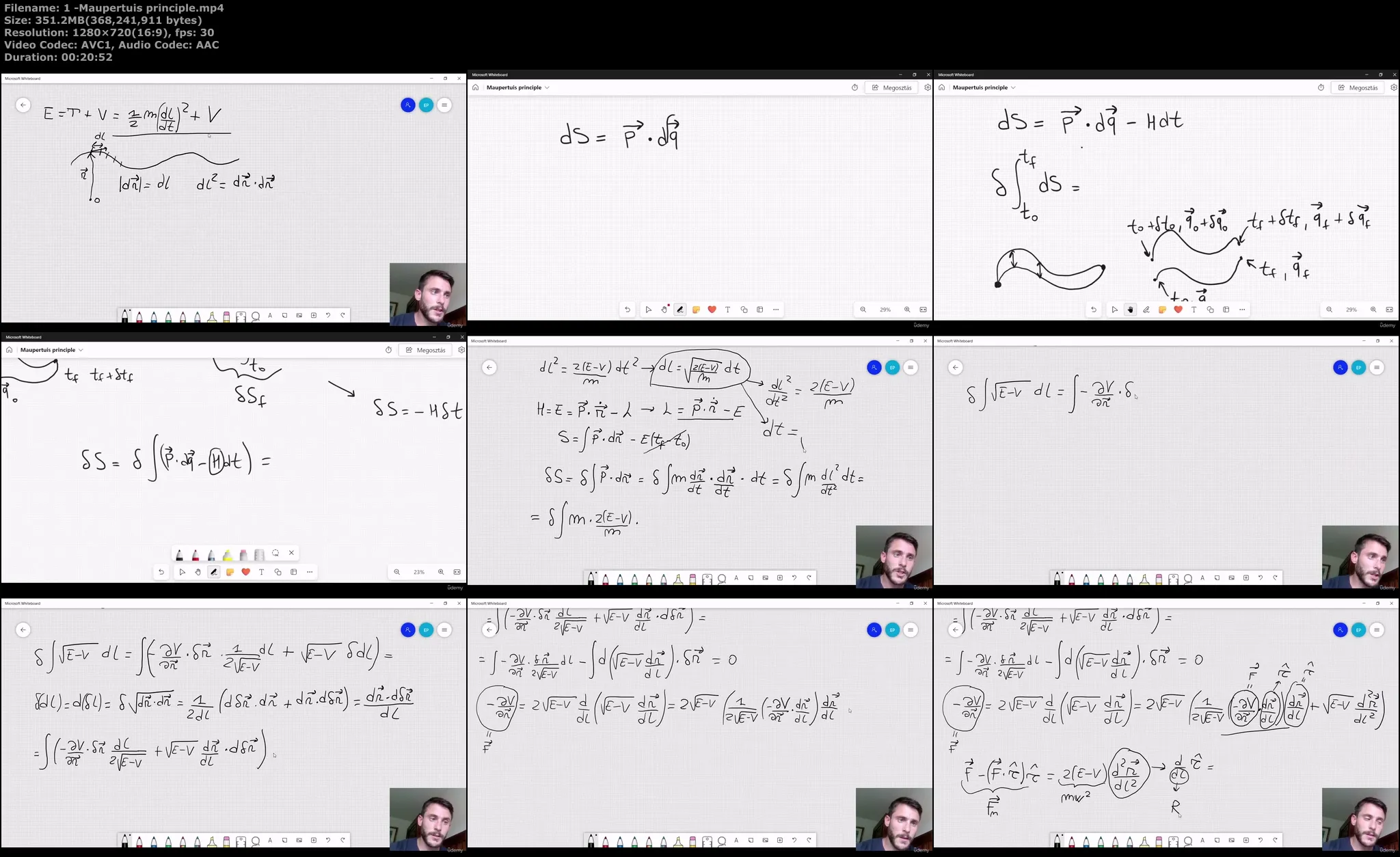Master Variational Calculus & Advanced Mathematical Methods
.MP4, AVC, 1280x720, 30 fps | English, AAC, 2 Ch | 27h 15m | 18.4 GB
Instructor: Emanuele Pesaresi
.MP4, AVC, 1280x720, 30 fps | English, AAC, 2 Ch | 27h 15m | 18.4 GB
Instructor: Emanuele Pesaresi
Calculus of Variations, Tensors, Fourier Transforms, Residues, Path integrals, Functional Derivatives, Optimization
What you'll learn
- Master the Calculus of Variations: Students will learn to derive and solve Euler-Lagrange equations, optimizing functionals to address real-world problems
- Apply Integral Transforms: Students will gain proficiency in using Laplace, Fourier, and other transforms to simplify and solve complex differential equations
- Understand and Utilize Tensor Analysis: Students will acquire a deep understanding of tensor theory, transformation rules, operations with tensors, and more.
- Apply tensors to real-world scenarios, such as determining geodesics, understanding curvature, and calculating stress and strain in various frames
- Implement Complex Analysis and Residue Calculus: Students will learn to evaluate complex integrals using residue theorems and apply these techniques to problems
- Learn to effectively use Fourier transforms, Laplace transforms, and residue theory for analyzing signals, solving differential equations, and more
- Apply Path Integrals and Functional Derivatives in Physics – Explore path integral formulation and functional derivatives
- Analyze Physical Systems with Canonical Transformations and Hamiltonian Mechanics – Understand canonical transformations, Poisson brackets, Hamiltonian dynamics
Requirements
- Learners should have a strong understanding of undergraduate-level calculus, including differentiation, integration, differential equations, vector calculus
- Familiarity with Linear Algebra: A good grasp of linear algebra concepts such as matrices, vectors, and eigenvalues is recommended.
- While prior experience with the specific topics covered is not required, learners should be comfortable with abstract mathematical reasoning and eager to tackle challenging material.
- Understanding of Classical Mechanics – Familiarity with Newtonian mechanics will be helpful, as many examples are drawn from physics.
- Prior Exposure to Complex Numbers and Basic Complex Calculus – Knowledge of complex numbers and introductory concepts in complex calculus (e.g., Euler's formula, polar form) is recommended
Description
This advanced course offers a rigorous exploration of the following pivotal mathematical disciplines: Calculus of Variations, Integral Transforms, Tensor Analysis, Complex Analysis (with a focus on Residue Theorems), intuition behind path integrals and Quantization of a classical theory, and a final part on constrained optimization problems. Designed for professionals, researchers, and students in mathematics, physics, engineering, and related fields, this course provides the theoretical foundations and practical techniques necessary to solve complex problems across a variety of disciplines.
What You Will Learn:
- Calculus of Variations: Delve into the principles of optimizing functionals, essential for understanding the behavior of systems in physics, engineering, and economics. Master techniques such as Euler-Lagrange equations, boundary conditions, and their applications in mechanics.
- Integral Transforms: Gain proficiency in Laplace, Fourier, and other integral transforms, which are powerful tools for solving differential equations and analyzing signals. Learn how to apply these transforms to simplify and solve complex mathematical problems.
- Tensor Analysis: Explore the theory and applications of tensors, which are indispensable in the study of continuum mechanics, relativity, and advanced geometry. Understand the mathematical structure of tensors, their transformations, and their role in physics and engineering. The introduction to tensors follows the pedagogical steps usually encountered in a course on General Relativity
- Complex Analysis and Residue Theorems: Study the intricacies of complex functions and the residue theorem, a cornerstone in evaluating integrals and solving differential equations. Learn how to apply residue calculus to solve real-world problems in physics and engineering.
- Path Integrals: Study the quantization of classical theories through the use of path integrals.
- Matematical connections between Classical and Quantum Physics: By including Poisson brackets, the path integral approach, the Schrödinger equation, and even the transition to Feynman diagrams, the course bridges the gap between classical mechanics and quantum mechanics, which is valuable for students aiming to transition from classical physics to quantum field theory (QFT).
- Basics of constrained optimization problems: Study the theory of Lagrange multipliers (building some additional "intuition" which is not usually offered in other courses), plus some practical applications.
ADDITIONAL COMMENTS
The course offers a thorough and structured approach to several advanced topics in mathematics and physics. It spans fundamental principles like the principle of least action and Hamiltonian mechanics, covers complex areas such as tensor calculus and general relativity, and delves into more abstract concepts like residues, Fourier and Laplace transforms, path integrals.
Here’s an analysis of key aspects:
1. Comprehensive Structure:
The syllabus moves logically from classical mechanics, variational principles, and tensors, to transforms and complex analysis. This builds on mathematical techniques and their physical applications, making it suitable for advanced learners.
2. Variety of Topics:
The course covers a wide range of topics including Hamiltonian mechanics, tensor analysis, general relativity, complex variables, and transforms like Fourier and Laplace. This gives students exposure to multiple branches of applied mathematics.
3. Real-world Applications:
With examples like the double pendulum, geodesics, strain tensors, etc, the course emphasizes real-world relevance, especially in physics and engineering contexts.
4. Engagement through Problem Solving:
The syllabus includes numerous practical problems and exercises (e.g., geodesics on surfaces of revolution, Fourier transform applications), which are essential for reinforcing understanding and building problem-solving skills.
5. Detailed Focus on Key Concepts:
Topics like the derivation of Einstein’s field equations, Poisson brackets, and the Maupertuis principle are handled in detail, allowing students to gain deep insights into fundamental areas of theoretical physics and calculus.
Final Thoughts:
The course is highly suited for students with a solid mathematical background, particularly those in physics or engineering. It balances theoretical depth with practical applications, making it a resource for mastering advanced calculus, tensors, and transforms.
Who Should Enroll:
- Advanced undergraduate and graduate students in mathematics, physics, and engineering.
- Professionals and researchers seeking to deepen their understanding of advanced mathematical methods.
- Anyone with a strong mathematical background interested in mastering these essential topics.
Course Features:
- In-depth lectures covering theoretical concepts and some practical applications.
- Step-by-step problem-solving sessions to solidify your understanding.
- Some examples and case studies to demonstrate the application of these mathematical techniques.
- Posing the right questions to test your knowledge and track your progress.
Prerequisites:
A solid understanding of undergraduate-level calculus, linear algebra, and differential equations is recommended.
Join this course to gain a deep, working knowledge of these critical mathematical tools and enhance your ability to tackle complex problems in both academic and professional settings.
Note: part of the material in this course serves as supplementary content for other physics courses taught by the instructor. While some of these physics courses provide a "self-contained" approach, a portion of this course (albeit a small one) is intentionally included in those courses as well, resulting in some overlap. However, the structured and logical sequence of topics in this course is designed to help students achieve a higher level of mathematical proficiency than they might achieve by studying the physics courses separately, detaching the mathematics from the physics (where this is possible).
REFERENCES
This course has been designed to reflect the instructor's unique perspective, with the aim of presenting essential information in a logical, concise, and original manner. Some of the course material draws inspiration from the following sources:
1. L. Landau and E. Lifshitz: Mechanics (Vol. 1)
2. L. Landau and E. Lifshitz: The Classical Theory of Fields (Vol. 2)
3. A. Einstein: The Foundation of the General Theory of Relativity, 1916
4. A. Einstein: Hamilton’s Principle and the General Theory of Relativity, 1916
5. A. Einstein: Cosmological Considerations on the General Theory of Relativity, 1917
6. B. A. Dubrovin, A. T. Fomenko, S. P. Novikov: Modern Geometry - Methods and Applications Part 1
7. L. Landau and E. Lifshitz: Theory of Elasticity (Vol. 7)
8. L. S. Schulman: Techniques and Applications of Path Integration
9. D. Skinner: Quantum Field Theory II (Lecture notes from the University of Cambridge)
Who this course is for:
- Advanced Students in Mathematics, Physics, and Engineering: Ideal for upper-level undergraduates, graduate students, and doctoral candidates who seek to deepen their understanding of advanced mathematical methods.
- Professionals and Researchers: Engineers, physicists, data scientists, and researchers in academia or industry who need to apply sophisticated mathematical tools to solve complex problems in their fields.
- Aspiring Academics and Educators: Those pursuing a career in teaching or academic research who wish to gain a thorough mastery of topics like calculus of variations, tensor analysis, and integral transforms.
- Enthusiasts with a Strong Mathematical Background: Individuals passionate about mathematics and theoretical sciences who want to explore higher-level concepts and their practical applications.





